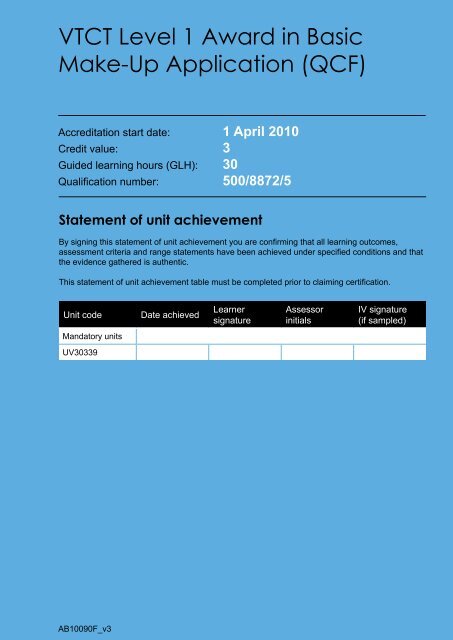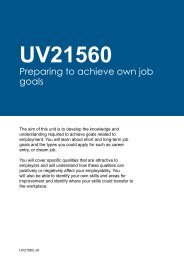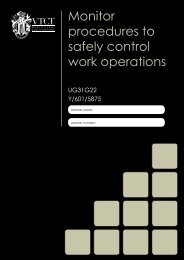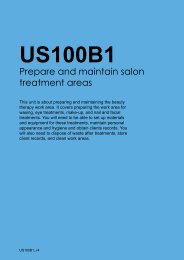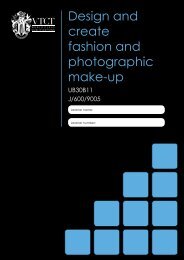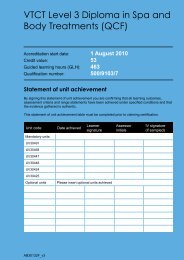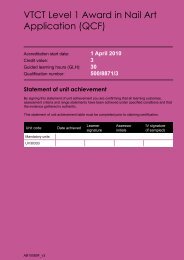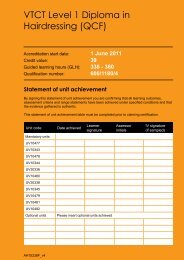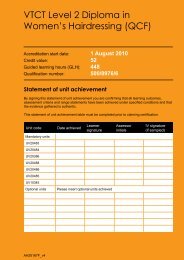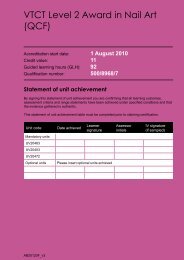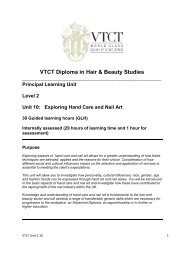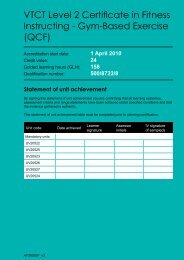VTCT Level 1 Award in Basic Make-Up Application (QCF)
VTCT Level 1 Award in Basic Make-Up Application (QCF)
VTCT Level 1 Award in Basic Make-Up Application (QCF)
You also want an ePaper? Increase the reach of your titles
YUMPU automatically turns print PDFs into web optimized ePapers that Google loves.
<strong>VTCT</strong> <strong>Level</strong> 1 <strong>Award</strong> <strong>in</strong> <strong>Basic</strong><br />
<strong>Make</strong>-<strong>Up</strong> <strong>Application</strong> (<strong>QCF</strong>)<br />
Accreditation start date: 1 April 2010<br />
Credit value:<br />
3<br />
Guided learn<strong>in</strong>g hours (GLH): 30<br />
Qualification number: 500/8872/5<br />
Statement of unit achievement<br />
By sign<strong>in</strong>g this statement of unit achievement you are confirm<strong>in</strong>g that all learn<strong>in</strong>g outcomes,<br />
assessment criteria and range statements have been achieved under specified conditions and that<br />
the evidence gathered is authentic.<br />
This statement of unit achievement table must be completed prior to claim<strong>in</strong>g certification.<br />
Unit code Date achieved<br />
Mandatory units<br />
UV30339<br />
AB10090F_v3<br />
Learner<br />
signature<br />
Assessor<br />
<strong>in</strong>itials<br />
IV signature<br />
(if sampled)
2<br />
The qualification<br />
Introduction National Occupational Standards (NOS)<br />
The <strong>VTCT</strong> <strong>Level</strong> 1 <strong>Award</strong> <strong>in</strong> <strong>Basic</strong> <strong>Make</strong>-<strong>Up</strong><br />
<strong>Application</strong> (<strong>QCF</strong>) will enable you to prepare for<br />
and carry out basic make-up application, us<strong>in</strong>g<br />
foundation, concealers, powder, eye products,<br />
cheek products and lip products.<br />
You will be able to prepare for make-up,<br />
carry out a sk<strong>in</strong> analysis and use consultation<br />
techniques. The treatment will also <strong>in</strong>volve<br />
check<strong>in</strong>g that the f<strong>in</strong>al result is to the satisfaction<br />
of the client.<br />
This course is suitable for learners who wish to<br />
progress to a make-up course which leads to<br />
employment.<br />
Units <strong>in</strong> this qualification have been mapped<br />
to the relevant NOS (where applicable). This<br />
qualification is accredited on the Qualifications<br />
and Credit Framework (<strong>QCF</strong>).<br />
This qualification is approved and supported by<br />
the Hairdress<strong>in</strong>g and Beauty Industry Authority<br />
(HABIA), the standard sett<strong>in</strong>g body for hair,<br />
beauty, nails and spa qualifications.
Progression<br />
When you have successfully completed this<br />
qualification you will have the opportunity to<br />
progress to the follow<strong>in</strong>g <strong>VTCT</strong> qualifications:<br />
• <strong>Level</strong> 2 NVQ Diploma <strong>in</strong> Beauty Therapy<br />
General (<strong>QCF</strong>)<br />
• <strong>Level</strong> 2 NVQ Diploma <strong>in</strong> Beauty Therapy<br />
<strong>Make</strong>-<strong>Up</strong> (<strong>QCF</strong>)<br />
Progression opportunities also exist <strong>in</strong> the<br />
form of specialist <strong>VTCT</strong> vocationally related<br />
qualifications:<br />
• <strong>Level</strong> 1 Certificate <strong>in</strong> Beauty Therapy<br />
(<strong>QCF</strong>)<br />
• <strong>Level</strong> 1 Diploma <strong>in</strong> Beauty Therapy (<strong>QCF</strong>)<br />
• <strong>Level</strong> 2 Certificate <strong>in</strong> Beauty Specialist<br />
Techniques (<strong>QCF</strong>)<br />
• <strong>Level</strong> 2 Diploma <strong>in</strong> Beauty Specialist<br />
Techniques (<strong>QCF</strong>)<br />
• <strong>Level</strong> 2 <strong>Award</strong> <strong>in</strong> the Art of Photographic<br />
<strong>Make</strong>-<strong>Up</strong> (<strong>QCF</strong>)<br />
• <strong>Level</strong> 2 Certificate <strong>in</strong> Cosmetic <strong>Make</strong>-<strong>Up</strong><br />
and Beauty Consultancy (<strong>QCF</strong>)<br />
• <strong>Level</strong> 2 Certificate <strong>in</strong> Cosmetic <strong>Make</strong>-<strong>Up</strong><br />
(<strong>QCF</strong>)<br />
• <strong>Level</strong> 2 Certificate <strong>in</strong> <strong>Make</strong>-<strong>Up</strong> and<br />
Manicure (<strong>QCF</strong>)<br />
3
4<br />
Qualification structure<br />
Total credits required - 3<br />
All mandatory units must be completed.<br />
Mandatory unit - 3 credits<br />
<strong>VTCT</strong> unit<br />
code<br />
Ofqual unit<br />
reference<br />
Unit title Credit value GLH<br />
UV30339 J/502/3797 <strong>Basic</strong> make-up application 3 30
Guidance on assessment<br />
This book conta<strong>in</strong>s the mandatory units that make up this qualification. Optional units will be<br />
provided <strong>in</strong> additional booklets (if applicable). Where <strong>in</strong>dicated, <strong>VTCT</strong> will provide assessment<br />
materials. Assessments may be <strong>in</strong>ternal or external. The method of assessment is <strong>in</strong>dicated <strong>in</strong><br />
each unit.<br />
Internal assessment<br />
(any requirements will be shown <strong>in</strong> the unit)<br />
Assessment is set, marked and <strong>in</strong>ternally<br />
verified by the centre to clearly demonstrate<br />
achievement of the learn<strong>in</strong>g outcomes.<br />
Assessment is sampled by <strong>VTCT</strong> external<br />
verifiers.<br />
External assessment<br />
(any requirements will be shown <strong>in</strong> the unit)<br />
Externally assessed question papers<br />
completed electronically will be set and marked<br />
by <strong>VTCT</strong>.<br />
Externally assessed hard-copy question papers<br />
will be set by <strong>VTCT</strong>, marked by centre staff and<br />
sampled by <strong>VTCT</strong> external verifiers.<br />
Assessment expla<strong>in</strong>ed<br />
<strong>VTCT</strong> courses are assessed and verified by<br />
centre staff. Work will be set to improve your<br />
practical skills, knowledge and understand<strong>in</strong>g.<br />
For practical elements, you will be observed<br />
by your assessor. All your work must be<br />
collected <strong>in</strong> a portfolio of evidence and crossreferenced<br />
to requirements listed <strong>in</strong> this record<br />
of assessment book.<br />
Your centre will have an <strong>in</strong>ternal verifier whose<br />
role is to check that your assessment and<br />
evidence is valid and reliable and meets <strong>VTCT</strong><br />
and regulatory requirements.<br />
An external verifier, appo<strong>in</strong>ted by <strong>VTCT</strong>, will<br />
visit your centre to sample and quality-check<br />
assessments, the <strong>in</strong>ternal verification process<br />
and the evidence gathered. You may be<br />
asked to attend on a different day from usual if<br />
requested by the external verifier.<br />
This record of assessment book is your<br />
property and must be <strong>in</strong> your possession when<br />
you are be<strong>in</strong>g assessed or verified. It must be<br />
kept safe. In some cases your centre will be<br />
required to keep it <strong>in</strong> a secure place. You and<br />
your course assessor will together complete<br />
this book to show achievement of all learn<strong>in</strong>g<br />
outcomes, assessment criteria and ranges.<br />
5
6<br />
Creat<strong>in</strong>g a portfolio of evidence<br />
As part of this qualification you are required to<br />
produce a portfolio of evidence. A portfolio will<br />
confirm the knowledge, understand<strong>in</strong>g and skills<br />
that you have learnt. It may be <strong>in</strong> electronic or<br />
paper format.<br />
Your assessor will provide guidance on how to<br />
prepare the portfolio of evidence and how to<br />
show practical achievement, and understand<strong>in</strong>g<br />
of the knowledge required to successfully<br />
complete this qualification. It is this booklet<br />
along with the portfolio of evidence that will<br />
serve as the prime source of evidence for this<br />
qualification.<br />
Evidence <strong>in</strong> the portfolio may take the follow<strong>in</strong>g<br />
forms:<br />
• Observed work<br />
• Witness statements<br />
• Audio-visual media<br />
• Evidence of prior learn<strong>in</strong>g or atta<strong>in</strong>ment<br />
• Written questions<br />
• Oral questions<br />
• Assignments<br />
• Case studies<br />
All evidence should be documented <strong>in</strong> the<br />
portfolio and cross referenced to unit outcomes.<br />
Construct<strong>in</strong>g the portfolio of evidence should not<br />
be left to the end of the course.<br />
Many frequently asked questions and other<br />
useful <strong>in</strong>formation are detailed <strong>in</strong> the <strong>VTCT</strong><br />
Candidate’s Handbook, which is available on<br />
the <strong>VTCT</strong> website at www.vtct.org.uk/students.<br />
Other questions should be addressed to the<br />
tutor, lecturer or assessor.
Unit assessment methods<br />
This section provides an overview of the assessment methods that make up each unit <strong>in</strong> this<br />
qualification. Detailed <strong>in</strong>formation on assessment is provided <strong>in</strong> each unit.<br />
Mandatory unit<br />
<strong>VTCT</strong> unit<br />
code<br />
Unit title<br />
External Internal<br />
Question<br />
paper(s)<br />
Observation(s) Assignment(s)<br />
UV30339 <strong>Basic</strong> make-up application 0 � �<br />
7
8<br />
Unit glossary<br />
<strong>VTCT</strong> product<br />
code<br />
Description<br />
All units are allocated a unique <strong>VTCT</strong> product code for identification purposes.<br />
This code should be quoted <strong>in</strong> all queries and correspondence to <strong>VTCT</strong>.<br />
Unit title The title clearly <strong>in</strong>dicates the focus of the unit.<br />
National<br />
Occupational<br />
Standards<br />
(NOS)<br />
<strong>Level</strong><br />
Credit value<br />
Guided<br />
learn<strong>in</strong>g hours<br />
(GLH)<br />
Observations<br />
Learn<strong>in</strong>g<br />
outcomes<br />
Evidence<br />
requirements<br />
Maximum<br />
service times<br />
Observation<br />
outcome<br />
Knowledge<br />
outcome<br />
Assessment<br />
criteria<br />
Range<br />
NOS describe the skills, knowledge and understand<strong>in</strong>g needed to undertake a<br />
particular task or job to a nationally recognised level of competence.<br />
<strong>Level</strong> is an <strong>in</strong>dication of the demand of the learn<strong>in</strong>g experience, the depth<br />
and/or complexity of achievement and <strong>in</strong>dependence <strong>in</strong> achiev<strong>in</strong>g the<br />
learn<strong>in</strong>g outcomes. There are 9 levels of achievement with<strong>in</strong> the Qualifications<br />
and Credit Framework (<strong>QCF</strong>).<br />
This is the number of credits awarded upon successful achievement of all unit<br />
outcomes. Credit is a numerical value that represents a means of recognis<strong>in</strong>g,<br />
measur<strong>in</strong>g, valu<strong>in</strong>g and compar<strong>in</strong>g achievement.<br />
GLH is an estimate of the time allocated to teach, <strong>in</strong>struct, assess and<br />
support learners throughout a unit. Learner <strong>in</strong>itiated private study, preparation<br />
and mark<strong>in</strong>g of formative assessment is not taken <strong>in</strong>to account.<br />
This <strong>in</strong>dicates the m<strong>in</strong>imum number of observations required to achieve the<br />
unit.<br />
The learn<strong>in</strong>g outcomes are the most important component of the unit, they set<br />
out what is expected <strong>in</strong> terms of know<strong>in</strong>g, understand<strong>in</strong>g and practical<br />
ability as a result of the learn<strong>in</strong>g process. Learn<strong>in</strong>g outcomes are the results<br />
of learn<strong>in</strong>g.<br />
This section provides guidel<strong>in</strong>es on how evidence must be gathered.<br />
The maximum time <strong>in</strong> which a particular service or practical element must be<br />
completed.<br />
An observation outcome details the practical tasks that must be completed to<br />
achieve the unit.<br />
A knowledge outcome details the theoretical requirements of a unit that must<br />
be evidenced through oral question<strong>in</strong>g, a mandatory written question paper or<br />
portfolio of evidence.<br />
Assessment criteria set out what is required, <strong>in</strong> terms of achievement, to meet<br />
a learn<strong>in</strong>g outcome. The assessment criteria and learn<strong>in</strong>g outcomes are the<br />
components that <strong>in</strong>form the learn<strong>in</strong>g and assessment that should take place.<br />
Assessment criteria def<strong>in</strong>e the standard expected to meet learn<strong>in</strong>g outcomes.<br />
The range <strong>in</strong>dicates what must be covered. Ranges must be practically<br />
demonstrated <strong>in</strong> parallel to the unit’s observation outcomes.
UV30339<br />
<strong>Basic</strong> make-up application<br />
This unit is about be<strong>in</strong>g able to prepare for and carry out<br />
basic make-up application us<strong>in</strong>g foundation, concealers,<br />
powder, eye, cheek and lip products. You will be able to<br />
prepare for make-up application, carry out sk<strong>in</strong> analysis<br />
and use consultation techniques. The treatment will also<br />
<strong>in</strong>volve check<strong>in</strong>g that the f<strong>in</strong>al result is to the satisfaction of<br />
the client.<br />
UV30339_v4
<strong>Level</strong><br />
Credit value<br />
GLH<br />
1<br />
3<br />
30<br />
Observation(s)<br />
3<br />
External paper(s)<br />
0
<strong>Basic</strong> make-up application<br />
Learn<strong>in</strong>g outcomes Evidence requirements<br />
On completion of this unit you will:<br />
1. Be able to prepare for make-up application<br />
2. Be able to carry out make-up application<br />
1. Environment<br />
Evidence for this unit must be gathered <strong>in</strong> a<br />
real or realistic work<strong>in</strong>g environment.<br />
2. Simulation<br />
Simulation is not allowed <strong>in</strong> this unit.<br />
3. Observation outcomes<br />
Competent performance of ‘Observation’<br />
outcomes must be demonstrated to your<br />
assessor on at least three occasions.<br />
4. Range<br />
All ranges must be practically demonstrated<br />
or other forms of evidence produced to<br />
show they have been covered.<br />
5. Knowledge outcomes<br />
There must be evidence that you possess<br />
all the knowledge and understand<strong>in</strong>g<br />
listed <strong>in</strong> the ‘Knowledge’ section of this<br />
unit. This evidence may <strong>in</strong>clude projects,<br />
assignments, case studies, reflective<br />
accounts, oral/written question<strong>in</strong>g and/or<br />
other forms of evidence.<br />
6. Tutor/Assessor guidance<br />
You will be guided by your tutor/assessor<br />
on how to achieve learn<strong>in</strong>g outcomes and<br />
ranges <strong>in</strong> this unit. All outcomes and ranges<br />
must be achieved.<br />
7. External paper<br />
There is no external paper requirement for<br />
this unit.<br />
UV30339<br />
11
12<br />
Achiev<strong>in</strong>g observations<br />
and range<br />
Achiev<strong>in</strong>g observation outcomes<br />
Your assessor will observe your performance<br />
of practical tasks. The m<strong>in</strong>imum number<br />
of observations required is <strong>in</strong>dicated <strong>in</strong> the<br />
evidence requirements section of this unit.<br />
Criteria may not always naturally occur dur<strong>in</strong>g<br />
a practical observation. In such <strong>in</strong>stances you<br />
will be asked questions to demonstrate your<br />
competence <strong>in</strong> this area. Your assessor will<br />
document the criteria that have been achieved<br />
through oral question<strong>in</strong>g.<br />
Your assessor will sign off an outcome when all<br />
criteria have been competently achieved <strong>in</strong> a<br />
s<strong>in</strong>gle client service.<br />
Achiev<strong>in</strong>g range<br />
The range section <strong>in</strong>dicates what must<br />
be covered. Ranges should be practically<br />
demonstrated as part of an observation. Where<br />
this is not possible other forms of evidence may<br />
be produced. All ranges must be covered.<br />
Your assessor will document the portfolio<br />
reference once a range has been competently<br />
achieved.<br />
UV30339<br />
Maximum service times<br />
The follow<strong>in</strong>g maximum service times apply to<br />
this unit:<br />
<strong>Basic</strong> make-up application 30 m<strong>in</strong>utes
Outcome 1<br />
Be able to prepare for make-up application<br />
You can:<br />
a. Prepare for apply<strong>in</strong>g basic make-up<br />
b. Select products, tools and equipment<br />
*May be assessed through oral question<strong>in</strong>g.<br />
Observations<br />
Observation 1 2 3<br />
Date achieved<br />
Criteria questioned orally<br />
Portfolio reference<br />
Assessor <strong>in</strong>itials<br />
Learner signature<br />
UV30339 13
14<br />
© Habia<br />
Outcome 2<br />
Be able to carry out make-up application<br />
You can:<br />
a. Prepare the face<br />
b. Apply basic make-up products<br />
c. Remove basic make-up<br />
d. Follow safe and hygienic work<strong>in</strong>g practices<br />
e. Communicate and behave <strong>in</strong> a professional<br />
manner<br />
*May be assessed through oral question<strong>in</strong>g.<br />
Observation<br />
Date achieved<br />
Criteria questioned orally<br />
Portfolio reference<br />
Assessor <strong>in</strong>itials<br />
Learner signature<br />
1 2 3<br />
UV30339
*You must practically demonstrate that you have:<br />
Range<br />
Used all consultation techniques Portfolio reference<br />
Question<strong>in</strong>g<br />
Visual<br />
Reference to client records<br />
Identified all sk<strong>in</strong> types Portfolio reference<br />
Oily<br />
Dry<br />
Comb<strong>in</strong>ation<br />
Carried out all forms of preparation of the client Portfolio reference<br />
Protection of cloth<strong>in</strong>g<br />
Removal of accessories<br />
Protection of hair<br />
Used all types of make-up products Portfolio reference<br />
Foundation<br />
Concealers<br />
Powder<br />
Eye products<br />
Cheek products<br />
Lip products<br />
*It is strongly recommended that all range items are practically demonstrated. Where this is not<br />
possible, other forms of evidence may be produced to demonstrate competence.<br />
UV30339 15
16<br />
© Habia<br />
*You must practically demonstrate that you have:<br />
Provided all types of advice Portfolio reference<br />
Suitable make-up products and their use<br />
Possible contra-actions and how to deal with them<br />
Suitable make-up re-application techniques<br />
Suitable make-up removal techniques<br />
*It is strongly recommended that all range items are practically demonstrated. Where this is not<br />
possible, other forms of evidence may be produced to demonstrate competence.<br />
UV30339
Achiev<strong>in</strong>g knowledge outcomes<br />
You will be guided by your tutor and assessor<br />
on the evidence that needs to be produced.<br />
Your knowledge and understand<strong>in</strong>g will be<br />
assessed us<strong>in</strong>g the assessment methods listed<br />
below:<br />
• Observed work<br />
• Witness statements<br />
• Audio-visual media<br />
• Evidence of prior learn<strong>in</strong>g or atta<strong>in</strong>ment<br />
• Written questions<br />
• Oral questions<br />
• Assignments<br />
• Case studies<br />
Develop<strong>in</strong>g knowledge<br />
Where possible your assessor will <strong>in</strong>tegrate<br />
knowledge outcomes <strong>in</strong>to practical observations<br />
through oral question<strong>in</strong>g.<br />
UV30339 17
18<br />
Knowledge<br />
Outcome 1<br />
Be able to prepare for make-up application<br />
You can:<br />
c. State the factors that could <strong>in</strong>fluence the choice of basic make-up<br />
products and techniques<br />
d. State the importance of the preparation procedures for apply<strong>in</strong>g<br />
basic make-up<br />
e. State how and when to use products, tools and equipment for<br />
basic make-up<br />
*Assessor <strong>in</strong>itials to be <strong>in</strong>serted if orally questioned.<br />
Requirements highlighted <strong>in</strong> white are assessed <strong>in</strong> the external paper.<br />
UV30339<br />
Portfolio reference /<br />
Assessor <strong>in</strong>itials*
Outcome 2<br />
Be able to carry out make-up application<br />
You can:<br />
f. State basic sk<strong>in</strong> types<br />
g. State the basic structure and function of the sk<strong>in</strong><br />
h. State the bone structure of the face<br />
*Assessor <strong>in</strong>itials to be <strong>in</strong>serted if orally questioned.<br />
Requirements highlighted <strong>in</strong> white are assessed <strong>in</strong> the external paper.<br />
Portfolio reference /<br />
Assessor <strong>in</strong>itials*<br />
© Habia<br />
UV30339 19
20<br />
Unit content<br />
This section provides guidance on the recommended knowledge and skills required to enable you<br />
to achieve each of the learn<strong>in</strong>g outcomes <strong>in</strong> this unit. Your tutor/assessor will ensure you have the<br />
opportunity to cover all of the unit content.<br />
Outcome 1: Be able to prepare for make-up application<br />
Management of health and safety<br />
at work: Clean<strong>in</strong>g up spillages, report<br />
slippery surfaces, remove/report obstacles,<br />
good all round access to trolleys and<br />
equipment, sterilise or dis<strong>in</strong>fect tools,<br />
equipment, work surfaces, personal<br />
protective equipment.<br />
Manual handl<strong>in</strong>g: Mov<strong>in</strong>g stock, lift<strong>in</strong>g,<br />
work<strong>in</strong>g heights, unpack<strong>in</strong>g, posture,<br />
deportment, balance, weight, preserve<br />
back, prevent slouch<strong>in</strong>g.<br />
Towels: Clean for every client, dirty towels<br />
<strong>in</strong> covered b<strong>in</strong>.<br />
Employer responsibility: Current and<br />
valid liability <strong>in</strong>surance, display health and<br />
safety rules cover<strong>in</strong>g staff, employees,<br />
clients and fire evacuation, provide<br />
regular tra<strong>in</strong><strong>in</strong>g, accurate record keep<strong>in</strong>g,<br />
monitor<strong>in</strong>g.<br />
Hazards: Someth<strong>in</strong>g with potential to<br />
cause harm, level of responsibility, report,<br />
nom<strong>in</strong>ated personnel, duty to recognise<br />
hazards.<br />
Risk: Likelihood of a hazard happen<strong>in</strong>g,<br />
risk assessment, determ<strong>in</strong>e the level of<br />
risk, preventative measures, reduce a<br />
potentially harmful situation, judgement<br />
of salon hazards who, what, level of risk,<br />
<strong>in</strong>terpret results, conclusions, record<br />
f<strong>in</strong>d<strong>in</strong>gs, regular reviews.<br />
Reasons for risk assessment: Staff,<br />
visitor, client health and safety, safe<br />
environment, m<strong>in</strong>imis<strong>in</strong>g hazards and risks,<br />
requirement of legislation.<br />
Hygiene (general): Sterilise and sanitise<br />
UV30339<br />
tools, dis<strong>in</strong>fect work surfaces, cover cuts<br />
and abrasions, sanitise therapist’s hands<br />
before and after treatments, sanitise with<br />
sprays and gels, clean towels between<br />
clients, dirty towels <strong>in</strong> covered b<strong>in</strong>,<br />
disposable towels, dispense products with<br />
a spatula, pump or spray, disposables used<br />
wherever possible, no smok<strong>in</strong>g, personal<br />
hygiene, replace loose lids (uncapped<br />
bottles and pots).<br />
Therapist posture and deportment:<br />
Correct posture when sitt<strong>in</strong>g, lift<strong>in</strong>g and<br />
carry<strong>in</strong>g, work<strong>in</strong>g methods to avoid<br />
Repetitive Stra<strong>in</strong> Injury (RSI), hand<br />
exercises, stand<strong>in</strong>g posture (even weight<br />
distribution), client comfort, ma<strong>in</strong>ta<strong>in</strong><br />
modesty, client correctly positioned to get<br />
maximum benefit from treatment, ensure<br />
therapist position<strong>in</strong>g delivers appropriate<br />
techniques, appropriate space between<br />
client and therapist, prevent <strong>in</strong>jury, optimum<br />
results, allow for visual checks.<br />
Work area: Clean and hygienic, height<br />
adjustable chair, correct posture, correct<br />
couch height, light<strong>in</strong>g, ventilation, noise,<br />
music, temperature, ambience, no trail<strong>in</strong>g<br />
wires, no obstructions, tools and equipment<br />
<strong>in</strong> a safe work<strong>in</strong>g position for therapist.<br />
Client preparation: Protect client cloth<strong>in</strong>g,<br />
client comfort, privacy, modesty, client<br />
positioned correctly.<br />
Communication:<br />
Verbal – speak<strong>in</strong>g manner and tone,<br />
professional, supportive, respectful,<br />
sensitive to client, open question<strong>in</strong>g related<br />
to treatment.
Outcome 1: Be able to prepare for make-up application (cont<strong>in</strong>ued)<br />
Non-verbal – eye contact, body language,<br />
listen<strong>in</strong>g.<br />
Record keep<strong>in</strong>g: Accurate appo<strong>in</strong>tment<br />
systems, stationery, loyalty, rewards,<br />
acknowledgement of occasions,<br />
consultation record keep<strong>in</strong>g, contra<strong>in</strong>dications,<br />
signatures, refer to exist<strong>in</strong>g<br />
records, <strong>in</strong>formation clear and accurate,<br />
logical order (name, address, contact<br />
numbers, age range, reason for treatment,<br />
occupation, sport/hobbies, medical<br />
history, allergies/hypersensitivity, contact<br />
lenses, contra-actions, contra-<strong>in</strong>dications,<br />
sk<strong>in</strong> sensitivity tests, adaptations and<br />
modifications, recommendations,<br />
requirement, treatment plan), update<br />
record at the end of the treatment,<br />
update at each visit, records ma<strong>in</strong>ta<strong>in</strong>ed<br />
electronically, paper records.<br />
Professional appearance: Clean<br />
professional uniform, no jewellery, hair<br />
neatly tied back, fr<strong>in</strong>ge secured, closed-<strong>in</strong><br />
footwear, make-up (light day make-up),<br />
personal hygiene and cleanl<strong>in</strong>ess (shower<br />
bath, cover cuts and abrasions, deodorant<br />
or antiperspirant, oral hygiene, clean teeth,<br />
fresh breath), nails (good condition and<br />
ma<strong>in</strong>ta<strong>in</strong>ed), no pierc<strong>in</strong>gs.<br />
Professional ethical conduct: Polite,<br />
cheerful and friendly manner, friendly facial<br />
expressions, positive attitude, eye contact,<br />
open body language, client relations,<br />
confidentiality, respect for colleagues and<br />
competitors, avoid gossip, pride <strong>in</strong> work,<br />
punctuality, employer and client loyalty.<br />
Consultation techniques: Client<br />
requirements, client satisfaction, client<br />
expectations and aftercare, signatures,<br />
visual, manual, question, listen, client<br />
card reference, use a range of related<br />
term<strong>in</strong>ology l<strong>in</strong>ked to basic make-up<br />
application.<br />
Factors to be considered: Face shape,<br />
eye colour, hair colour, sk<strong>in</strong> colour, type<br />
and texture, outfit colour, natural daylight,<br />
artificial daylight, occasion, fashion trends,<br />
cultural factors.<br />
Products: Concealers, foundations,<br />
powder, cream or powder blusher, cream<br />
or powder eyeshadow, eyel<strong>in</strong>er, mascara,<br />
lipstick, lipgloss, make-up remover,<br />
cleans<strong>in</strong>g milk, gel or cream.<br />
Tools: Brushes, palette, sponges,<br />
headband, tissues, gowns, towels, cotton<br />
wool, disposable applicators.<br />
Equipment: Chair with head and neck<br />
support, tools with<strong>in</strong> easy reach.<br />
Contra-<strong>in</strong>dications:<br />
Example of contra-<strong>in</strong>dications that<br />
may prevent treatment – severe sk<strong>in</strong><br />
conditions, eye <strong>in</strong>fections, conjunctivitis,<br />
bacterial <strong>in</strong>fections, <strong>in</strong>festations,<br />
<strong>in</strong>flammation or swell<strong>in</strong>g of the face,<br />
undiagnosed lumps, eye diseases<br />
or disorders, positive patch test,<br />
hypersensitive sk<strong>in</strong>, bruis<strong>in</strong>g, cuts and<br />
abrasions.<br />
Examples of contra-<strong>in</strong>dications that<br />
may restrict treatment – m<strong>in</strong>or bruis<strong>in</strong>g,<br />
m<strong>in</strong>or eczema, m<strong>in</strong>or psoriasis, m<strong>in</strong>or<br />
<strong>in</strong>flammation of the sk<strong>in</strong>, facial pierc<strong>in</strong>g,<br />
cold sores, impetigo.<br />
© Habia<br />
UV30339 21
22<br />
© Habia<br />
Outcome 2: Be able to carry out make-up application<br />
Sk<strong>in</strong> types: Oily, dry, comb<strong>in</strong>ation.<br />
<strong>Application</strong> technique for basic makeup:<br />
Base preparation – cleanse, tone,<br />
moisturise, conceal, translucent powder,<br />
foundation, translucent powder, bronzer if<br />
required.<br />
Eyebrows – brush through, apply eyebrow<br />
powder or pencil, clear mascara.<br />
Eyes – apply neutral shadow over area,<br />
eye shadow colours, eyel<strong>in</strong>er, mascara.<br />
Blusher – cheek area, highlight, contour.<br />
Lips – l<strong>in</strong>e, lipstick, lipgloss.<br />
Examples of possible contra-actions:<br />
Allergic reaction to eye products –<br />
sensitivity or burn<strong>in</strong>g sensation, remove all<br />
products immediately, use eye bath to flush<br />
eye, advise client to seek medical advice,<br />
ma<strong>in</strong>ta<strong>in</strong> records.<br />
Allergic reaction to sk<strong>in</strong> make-up<br />
products – redness, itch<strong>in</strong>g, swell<strong>in</strong>g,<br />
rash, burn<strong>in</strong>g or st<strong>in</strong>g<strong>in</strong>g, blister<strong>in</strong>g (remove<br />
make-up or sk<strong>in</strong> product immediately with<br />
suitable remover, clean area with water,<br />
advise client to seek medical advice,<br />
ma<strong>in</strong>ta<strong>in</strong> records).<br />
Aftercare advice:<br />
Removal of make-up – eye makeup<br />
remover on a cotton bud, circular<br />
movements from the outer corner of the<br />
eye, removal of make-up (cleanse, tone,<br />
moisturise).<br />
Retail products – make-up ranges for<br />
sk<strong>in</strong> tone, colour, sk<strong>in</strong> type, application<br />
techniques for home care products.<br />
UV30339<br />
Sk<strong>in</strong>:<br />
Epidermis – basal cell layer, prickle cell<br />
layer, granular layer, clear layer, horny<br />
layer.<br />
Dermis – blood and lymph supply,<br />
collagen, elast<strong>in</strong>, hair, sebaceous glands,<br />
arrector pili muscle, sweat glands, sensory<br />
nerve end<strong>in</strong>gs.<br />
Hypodermis – fat cells.<br />
Awareness of the basic functions of<br />
the sk<strong>in</strong> – protection, heat regulation,<br />
absorption, secretion, elim<strong>in</strong>ation,<br />
sensation, formation of vitam<strong>in</strong> D, melan<strong>in</strong><br />
production.<br />
Awareness of the position of major<br />
facial bones: Frontal (forehead),<br />
zygomatic (cheek), nasal (nose), mandible<br />
(lower jaw), maxillae (upper jaw).


